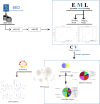Discovering periodontitis biomarkers and therapeutic targets through bioinformatics and ensemble learning analysis
- PMID: 41044121
- PMCID: PMC12494746
- DOI: 10.1038/s41598-025-18017-7
Discovering periodontitis biomarkers and therapeutic targets through bioinformatics and ensemble learning analysis
Abstract
Periodontitis, a prevalent inflammatory disease, leads to the progressive destruction of periodontal tissues and poses significant systemic health risks. Despite its widespread impact, the molecular mechanisms driving periodontitis remain poorly understood. This study integrates advanced ensemble machine learning models and bioinformatics approaches to elucidate the genetic basis of periodontitis. Using transcriptomic data from the gene expression omnibus (GEO) repository (GSE10334), we identified 21 common genes from bagging and boosting models, underscoring their critical role in disease pathophysiology. Protein-protein interaction (PPI) network analysis revealed hub genes (HNRNPC, TSR1, PLRG1, GOPC) with central roles in key biological pathways. Functional enrichment highlighted their involvement in actin filament regulation, immune response modulation, and RNA processing. Furthermore, mutation and copy number alteration (CNA) analyses revealed significant genetic diversity in these hub genes, particularly in diploid samples, with a high prevalence of missense and splice variants. Together, these findings advance our understanding of the molecular landscape of periodontitis, paving the way for novel biomarker discovery and targeted therapeutic strategies potentially leading to improved diagnostic and treatment approaches in periodontal care.
Keywords: Biomarker; Ensemble learning model; Machine learning; Mutation and copy number alteration; Periodontitis; Protein-protein interaction.
© 2025. The Author(s).
Conflict of interest statement
Declarations. Competing interests: The authors declare no competing interests.
Figures









References
-
- Jacobs, R., Fontenele, R. C., Lahoud, P., Shujaat, S. & Bornstein, M. M. Radiographic diagnosis of periodontal diseases - Current evidence versus innovations. Periodontol. 200095 (1), 51–69. 10.1111/prd.12580 (2024). - PubMed
-
- Mallya, S. M., Tetradis, S. & Dwarakanath, C. D. Radiographic Aids in the Diagnosis. Newman and Carranza’s Clinical Periodontology: 4th South Asia Edition-E-Book. 313 (2024).
-
- Tonetti, M. S., Greenwell, H. & Kornman, K. S. Staging and grading of periodontitis: framework and proposal of a new classification and case definition. J. Periodontol. 89 (Suppl 1), S159–S172. 10.1002/JPER.18-0006 (2018). - PubMed
MeSH terms
Substances
LinkOut - more resources
Full Text Sources
Miscellaneous

